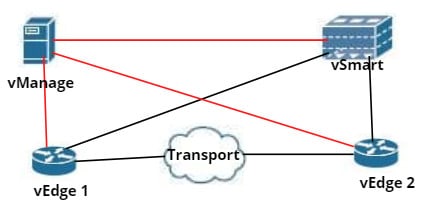Software-Defined Wide Area Network was introduced to provide a more secure and reliable connection at a lesser cost. Software-Defined WAN is a combination of Internet and private WAN connection to meet business requirements for reliable VPN and internet connection.
What is a Software-Defined Wide Area Network?
Software-Defined WAN is a WAN optimization and automation that uses network services (WAN) such as MPLS, DSL, and 5G/LTE as their direct internet access and connection to other branches, data centers, and colocation facilities. It automatically routes traffic across multiple WAN connections based on the policies you define.
Software-Defined WAN uses a centralized controller to transfer the traffic securely and dynamically across different WAN connections based on defined requirements or policies on the controller. Organizations are able to reduce their IT cost and deliver high quality network performance to end-user with centralized management and control.
SD-WAN Operation
Software-Defined WAN architecture has a centralized controller that is responsible for automation, control, and centralized management and configuration. On SD-WAN services, hybrid WANs such as MPLS, LTE, and broadband internet services are being utilized and creating a load-balancing connection as per application requirements. It uses an active-active or active-standby multi-WAN setup.
Application traffic can be dynamically assigned to different WAN links based on defined policies. For example, sensitive traffic can be allotted to MPLS connection as it requires a guaranteed bandwidth. SD-WAN work when the active WAN traffic is experiencing high latency and lower throughput, failover happens. Failback happens if the previous active WAN link has met the policy-defined requirement. By using SD-WAN solutions, it can help to better utilize the hybrid WAN (MPLS/DSL/broadband) and increase application availability and performance.
Cisco SD-WAN Architecture
Cisco Software-Defined WAN (previously called Viptela) is the SD-WAN technology offered by Cisco. The SD-WAN solution consists of four main components:
1. vEdge
vEdge is responsible for the data plane and can either be a virtual or physical router. vEdge is responsible for routing and forwarding in the SD-WAN architecture. Each router uses IPSec encryption to provide a secure connection. Common Cisco vEdge routers for hardware SD-WAN devices are Viptela OS Routers and IOS XE SD-WAN Routers and for virtual SD-WAN appliances are vEdge Cloud and Cisco Cloud Services Router (CSR).
2. vSmart
vSmart is responsible for the control plane and is available as a virtual machine. It is the controller of the network that advertises security, routes, and defined policy. vSmart is responsible for managing all data and control policies using Overlay Management Protocol (OMP).
3. vManage
vManage is responsible for the management plane and can be viewed in GUI. It is a centralized portal for managing and configuring the software and hardware in SD-WAN architecture. vManage authenticates the vSmart controller and vEdge router. It is the NMS of the Software-Defined WAN network infrastructure where you can configure and create policies for the device.
4. vBond
vBond is the orchestrator that authenticates the vSmart controller, vEdge router, vManage within the SD-WAN network. It can either be available as hardware or virtual appliances. vBond initiates the initialization process of every vEdge router. It creates a secure tunnel with vEdge then tells vSmart and vManage about its configuration and parameters, such as the IP address.
The below diagram shows the SD-WAN architecture:
Zero Touch Provisioning (ZTP)
Zero Touch Provisioning (ZTP) service is a Cloud-based automatic provisioning of network devices in a remote location, without sending a network engineer to the site. ZTP limits human errors and efficiently installs and upgrades device software images and also installs configuration files on the network devices in the entire network.
Download our Free CCNA Study Guide PDF for complete notes on all the CCNA 200-301 exam topics in one book.
We recommend the Cisco CCNA Gold Bootcamp as your main CCNA training course. It’s the highest rated Cisco course online with an average rating of 4.8 from over 30,000 public reviews and is the gold standard in CCNA training:

